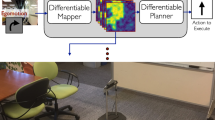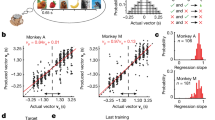Abstract
To behave in a robust and adaptive way, animals must extract task-relevant sensory information efficiently. One way to understand how they achieve this is to explore regularities within the information animals perceive during natural behavior. In this chapter, we describe how we have used artificial neural networks (ANNs) to explore efficiencies in vision and memory that might underpin visually guided route navigation in complex worlds. Specifically, we use three types of neural network to learn the regularities within a series of views encountered during a single route traversal (the training route), in such a way that the networks output the familiarity of novel views presented to them. The problem of navigation is then reframed in terms of a search for familiar views, that is, views similar to those associated with the route. This approach has two major benefits. First, the ANN provides a compact holistic representation of the data and is thus an efficient way to encode a large set of views. Second, as we do not store the training views, we are not limited in the number of training views we use and the agent does not need to decide which views to learn.
Access this chapter
Tax calculation will be finalised at checkout
Purchases are for personal use only
Similar content being viewed by others
Notes
- 1.
Here Lettvin and colleagues found that parts of the frog’s visual system are tuned to detect small moving objects. Thus the eye is providing information to the frog about where to direct the tongue in the hope of catching a fly. McCulloch and Pitts, authors of this paper, are commonly held up as pioneers of neural network research. J. Y. Lettvin, H. R. Maturana, W. S. McCulloch, and W. H. Pitts, “What the Frog’s Eye Tells the Frog’s Brain,” Proc. IRE 47 (1959) 1940–1951.
- 2.
Lettvin again came up with the concept of a sparse code in the brain where small numbers of individual neurons may be highly selective to concepts such as one’s grandmother. See Quian-Quiroga, R., Fried, I., and Koch, C. (2013) Brain Cells for Grandmother. Scientific American, Feb.
References
Jékely G, Colombelli J, Hausen H et al (2008) Mechanism of phototaxis in marine zooplankton. Nature 456(7220):395–399
von Uexküll J (1931) Der Organismus und die Umwelt. In Driesch H, Woltereck H. (Eds.), Das Lebensproblem im Lichte der modernen Forschung, Quelle und Meyer, Leipzig, pp 189–224
Nagel T (1974) What is it like to be a bat? Philos Rev 83:435–450
Shettleworth SJ (2010) Clever animals and killjoy explanations in comparative psychology. Trends Cogn Sci 14(11):477–481. doi:10.1016/j.tics.2010.07.002
Wehner R (2009) The architecture of the desert ant’s navigational toolkit (Hymenoptera: Formicidae). Myrmecological News 12:85–96
Hölldobler B (1990) The ants. Harvard University Press, Cambridge, MA
Collett TS, Graham P, Harris RA et al (2006) Navigational memories in ants and bees: Memory retrieval when selecting and following routes. Adv Study Behav 36:123–172. doi: 10.1016/S0065-3454(06)36003-2
Zeil J, Hofmann MI, Chahl JS (2003) The catchment areas of panoramic snapshots in outdoor scenes. J Opt Soc Am A Opt Image Sci Vis 20:450–469
Philippides A, Baddeley B, Cheng K et al (2011) How might ants use panoramic views for route navigation? J Exp Biol 214(3):445–451. doi: 10.1242/Jeb.046755
Wystrach A, Philippides A, Aurejac A et al (2014) Visual scanning behaviours and their role in the navigation of the Australian desert ant Melophorus bagoti. J Comp Physiol A:1–12
Mangan M, Webb B (2012) Spontaneous formation of multiple routes in individual desert ants (Cataglyphis velox). Behav Ecol 23(5):944–954. doi: 10.1093/beheco/ars051
Wystrach A, Beugnon G, Cheng K (2012) Ants might use different view-matching strategies on and off the route. J Exp Biol 215(1):44–55. doi:10.1242/Jeb.059584
Collett M (2010) How desert ants use a visual landmark for guidance along a habitual route. Proc Natl Acad Sci U S A 107(25):11638–11643. doi:10.1073/pnas.1001401107
Graham P, Cheng K (2009) Ants use the panoramic skyline as a visual cue during navigation. Curr Biol 19(20):R935–R937
Wystrach A, Graham P (2012) What can we learn from studies of insect navigation? Anim Behav 84(1):13–20. doi:10.1016/j.anbehav.2012.04.017
Baddeley B, Graham P, Philippides A et al (2011) Holistic visual encoding of ant-like routes: navigation without waypoints. Adapt Behav 19(1):3–15. doi:10.1177/1059712310395410
Viola P, Jones M (2001) Rapid object detection using a boosted cascade of simple features. In: Computer vision and pattern recognition, 2001. CVPR 2001. Proceedings of the 2001 IEEE Computer Society Conference on, 2001. IEEE, vol 511. pp I-511–I-518
Freund Y, Schapire R, Abe N (1999) A short introduction to boosting. J Jpn Soc Artif Intell 14(771–780):1612
Hinton GE, Salakhutdinov RR (2006) Reducing the dimensionality of data with neural networks. Science 313(5786):504–507
Smolensky P (1986) Information processing in dynamical systems: foundations of harmony theory. In Rumelhart D, McClelland J, the PDP Research Group (Eds.). Parallel distributed processing: Explorations in the microstructure of cognition. Vol. 1: Foundations. MIT Press, Cambridge, MA, pp 194–281
Hinton GE (2002) Training products of experts by minimizing contrastive divergence. Neural Comput 14(8):1771–1800
Ackley DH, Hinton GE, Sejnowski TJ (1985) A learning algorithm for Boltzmann machines. Cognit Sci 9(1):147–169
Hinton GE, Sejnowski TJ (1986) Learning and relearning in Boltzmann machines. MIT Press, Cambridge, MA, 1 (282–317):4.2
Hinton G (2010) A practical guide to training restricted Boltzmann machines. Momentum 9(1):926
Baddeley B, Graham P, Philippides A et al (2011) Models of visually guided routes in ants: embodiment simplifies route acquisition. Intelligent robotics and applications. Springer, New York, pp 75–84
Lulham A, Bogacz R, Vogt S et al (2011) An infomax algorithm can perform both familiarity discrimination and feature extraction in a single network. Neural Comput 23(4):909–926
Bell AJ, Sejnowski TJ (1995) An information-maximization approach to blind separation and blind deconvolution. Neural Comput 7(6):1129–1159
Lee T-W, Girolami M, Sejnowski TJ (1999) Independent component analysis using an extended infomax algorithm for mixed subgaussian and supergaussian sources. Neural Comput 11(2):417–441
Amari S-I, Cichocki A, Yang HH (1996) A new learning algorithm for blind signal separation. Adv Neural Inform Process Syst 8:757–763
Muller M, Wehner R (2010) Path integration provides a scaffold for landmark learning in desert ants. Curr Biol 20(15):1368–1371. doi:10.1016/j.cub.2010.06.035
Wehner R, Wehner S (1990) Insect navigation—use of maps or ariadnes thread. Ethol Ecol Evol 2(1):27–48
Author information
Authors and Affiliations
Corresponding author
Editor information
Editors and Affiliations
Rights and permissions
Copyright information
© 2015 Springer Science+Business Media New York
About this protocol
Cite this protocol
Philippides, A., Graham, P., Baddeley, B., Husbands, P. (2015). Using Neural Networks to Understand the Information That Guides Behavior: A Case Study in Visual Navigation. In: Cartwright, H. (eds) Artificial Neural Networks. Methods in Molecular Biology, vol 1260. Springer, New York, NY. https://doi.org/10.1007/978-1-4939-2239-0_14
Download citation
DOI: https://doi.org/10.1007/978-1-4939-2239-0_14
Published:
Publisher Name: Springer, New York, NY
Print ISBN: 978-1-4939-2238-3
Online ISBN: 978-1-4939-2239-0
eBook Packages: Springer Protocols




